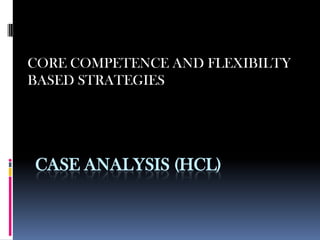Case analysis (hcl)
- 1. CASE ANALYSIS (HCL) CORE COMPETENCE AND FLEXIBILTY BASED STRATEGIES
- 2. INTRODUCTION- ï§ HCL (Hindustan Computers Limited) is a leading global Technology and IT enterprise whose range of services spans Product Engineering andTechnology Development, Application Services, BPO Services, Infrastructure Services, IT Hardware, Systems Integration, and Distribution ofTechnology and Telecom products in India.
- 3. HCL Today ï§ The HCL Enterprise comprises two companies listed in India: HCL Technologies and HCL Infosystems. HCL Technologies is the IT and BPO services arm focused on global markets, while HCL Infosystems deals in the IT, Communication, Office Automation Products & System Integration arm focused on the Indian market. Today, HCL has 45,000 employees of diverse nationalities, operating across 17 countries including 360 service centers in India. ï§ HCL has global partnerships with several leading Fortune 1000 firms, including several IT andTechnology majors.
- 4. HUMAN RESOURCES COMPETENCIES ï§ Trained professionals ï§ People oriented-ness ï§ Human innovativeness ï§ Talent and creativity of HR ï§ Dedication of employees
- 5. HCLâs current HR strategies ï§ Managing People up to Speed with IT ï§ Bringing People up to Speed with IT ï§ Training ï§ Speciality of Work force
- 6. MARKETING COMPETENCIES OF HCL ï§ Focus on customer solutions through human value addition ï§ Effective distribution system ï§ Global presence
- 7. R&D COMPETENCIES ï§ Continuous technology development and up gradation ï§ One of the best software development centers in the world
- 8. FINANCIAL COMPETENCIES ï§ Strong financial position ï§ Returns above industry average
- 9. Ratios Industry average 1998-97 1997-96 1996-95 Net Profit Ratio 8.92 6.94 7.37 Rate of Return on Fixed Assets 29.96 28.92 32.64 Rate of Return on Total Assets 10.83 8.41 9.89 Return on capital Employed 31.83 31.42 31.07 Return on Shareholdersâ Equity 26.84 22.57 23.65 Divident payout (D/P) Ratio 0.33 0.55 0.02
- 10. Ratios Fiscal year 2011 2010 Net Profit Ratio 17.22 20.18 Rate of Return on Fixed Assets 2.73 2.56 Return on capital Employed 85.04 77.92 Return on Shareholdersâ Equity 7.5 4.00 Dividend payout (D/P) Ratio 49.97 29.86
- 11. Core Competencies ï§ A core competency is a concept in management theory originally advocated by CK Prahalad, and Gary Hamel, two business book writers. In their view a core competency is a specific factor that a business sees as being central to the way it, or its employees, works. It fulfills three key criteria: 1. It is not easy for competitors to imitate. 2. It can be re-used widely for many products and markets. 3. It must contribute to the end consumer's experienced benefits.
- 12. ï§ A core competency can take various forms, including technical/subject matter know-how, a reliable process and/or close relationships with customers and suppliers. It may also include product development or culture, such as employee dedication, best Human Resource Management (HRM), good market coverage etc. ï§ Core competencies are particular strengths relative to other organizations in the industry which provide the fundamental basis for the provision of added value. Core competencies are the collective learning in organizations, and involve how to coordinate diverse production skills and integrate multiple streams of technologies. It is communication, an involvement and a deep commitment to working across organizational boundaries. Few companies are likely to build world leadership in more than five or six fundamental competencies
- 13. Competitive advantage ï§ When a firm sustains profits that exceed the average for its industry, the firm is said to possess a competitive advantage over its rivals. The goal of much of business strategy is to achieve a sustainable competitive advantage. ï§ A competitive advantage exists when the firm is able to deliver the same benefits as competitors but at a lower cost (cost advantage), or deliver benefits that exceed those of competing products (differentiation advantage). Thus, a competitive advantage enables the firm to create superior value for its customers and superior profits for itself.














